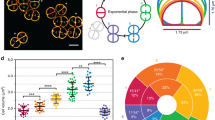Abstract
Previously nuclear reformation following metaphase in HeLaS3 cells was conceptualized in terms of a stepwise process which was continuous throughout anaphase and telophase. This concept was based on a three-dimensional visualization by scanning electron microscopy (SEM) of individual, organically prepared chromatid structures (prenuclei) which could be sequentially arranged. Morphologic analysis revealed unique topographies and morphometric properties which suggested that it should be possible to isolate populations of prenuclei aqueously. Such an isolation using detergents and density centrifugation is presented which yields metaphase plates and two populations of prenuclei with distinctive morphology. Essentially, prenuclei are freed from late mitotic cells in suspension cultures of synchronized HeLaS3 cells by treatment with 0.1% Nonidet-P40 followed by treatment with a mixture of Tween 40-desoxycholate (0.5%). Critical for the isolation is the presence of a divalent cation (5 mM Mg+ +) and an acid pH (~ 5.8). After density centrifugation, 2N decondensing structures (late intermediates) are recovered from 42% Percoll, and a mixture of 2N predecondensing (early intermediates) and 4N metaphase plates are recovered from 52% Percoll. The latter intermediates can be further separated into highly enriched populations (>94% pure) by fluorescence-activated sorting. Predecondensing structures are of the same overall morphology as prenuclei isolated previously by organic means, can also be ordered sequentially to demonstrate nuclear morphogenesis, and retain centromere/kinetochore loci. These chromosomal loci based on immunostaining of individual structures appear to be positioned centrally during chromatid reassociation and then appear to be dispersed prior to structural rearrangements leading to formation of a disc-like prenucleus. The significance of grouping intermediates temporally and of two protocols of isolation yielding the same structures is discussed with regard to a study of the requirements for nuclear morphogenesis in late mitosis.
Similar content being viewed by others
References
Burke B, Gerace L (1986) A cell free system to study reassembly of nuclear envelope at the end of mitosis. Cell 44:639–652
Capco GD, Penman S (1983) Mitotic architectures of the cell: The filament networks of the nucleus and cytoplasm. J Cell Biol 96:896–906
Coulter Epics V System Product Reference Manual (1984) Sections 3.22 to 3.38, pp 3–7
Earnshaw WC, Rothfield N (1985) Identification of a family of human centromere proteins using autoimmune sera from patients with scleroderma. Chromosoma 91:313–321
Erlandson RA, deHarven E (1971) The ultrastructure of synchronized HeLa cells. J Cell Sci 8:353–397
Fisher PA (1987) Disassembly and reassembly of nuclei in cell-free systems. Cell 48:175–176
Gerace L, Blobel G (1980) The nuclear envelope lamina is reversibly depolymerized during mitosis. Cell 19:277–287
Henry SM, Hodge LD (1983) Nuclear matrix: A cell-cycle dependent site of increased intranuclear protein phosphorylation. Eur J Biochem 133:23–29
Hodge LD, Mancini P, Davis FM, Heywood P (1977) Nuclear matrix of HeLaS3 cells: Polypeptide composition during adenovirus infection and in phases of the cell cycle. J Cell Biol 72:194–208
Lazarides E (1985) Asembly and morphogenesis of the avian erythrocyte cytoskeleton. In: Borisy GG, Cleveland DW, Murphy DB (eds) Molecular biology of the cytoskeleton. Cold Spring Harbor Laboratory, Cold Spring Harbor, NY, pp 131–150
Lewis C, Laemmli U (1982) Higher order metaphase chromosome structure: evidence for metalloprotein interactions. Cell 29:171–181
Lewis CD, Lebkowski JS, Daly AK, Laemmli UK (1984) Interphase nuclear matrix and metaphase scaffolding structures. J Cell Sci [Suppl] 1:103–122
Masumoto H, Sugimoto K, Okazaki T (1989) Alphoid satellite DNA is tightly associated with centromere antigens in human chromosomes. Exp Cell Res 181:181–196
Merril CR, Goldman D, Sedman SA, Ebert MH (1982) Simplified silver protein detection and image enhancement methods in polyacrylamide gels. Electrophoresis 3:17
Mitchell AR, Gosden JR, Miller DA (1985) A cloned sequence, p82H, of the alphoid repeated DNA family found at the centromeres of all human chromosomes. Chromosoma 92:369–377
Newport J (1987) Nuclear reconstruction in vitro: stages of assembly around protein-free DNA. Cell 48:206–217
Shapiro HM (1988) In: Practical flow cytometry, 2nd Edition. Alan R. Liss, New York, NY, pp 106–114
Shatkin AJ (1969) Fractionation of RNA, DNA and protein by the use of isotopic precursors followed by chemical fractionation. In: Habel K, Salzman NP (eds) Fundamental techniques in virology, pp 238–241
Simmons T, Heywood P, Hodge LD (1973) Nuclear envelope associated resumption of RNA synthesis in late mitosis of HeLa cells. J Cell Biol 59:150–164
Spiegelman BM, Farmer SR (1982) Decreases in tubulin actin gene expression prior to morphological differentiation of 3T3 adipocytes. Cell 29:53–60
Valdivia MM, Brinkley BR (1985) Fractionation and initial characterization of the kinetochore from mammalian metaphase chromosomes. J Cell Biol 101:1124–1134
Welter DA, Black DA, Hodge LD (1984) Chromosome stabilizing structures in mitotic Indian muntjac (Muntiacus muntjak) cells. Experientia 40:871–873
Welter DA, Black DA, Hodge LD (1985) Nuclear reformation following metaphase in HeLaS3 cells: Three-dimentional visualization of chromatid rearrangements. Chromosoma 93:57–69
Welter DA, Black DA, Hodge LD (1986) Chromatid behavior in late mitosis: A scanning electron microscopy analysis of mammalian cell lines with various chromosome numbers. Scanning Electron Microsc IV:1371–1379
Author information
Authors and Affiliations
Rights and permissions
About this article
Cite this article
Hodge, L.D., Martinez, J.E., Allsbrook, W.C. et al. Intermediate structures in nuclear morphogenesis following metaphase from HeLaS3 cells can be isolated and temporally grouped. Chromosoma 99, 169–182 (1990). https://doi.org/10.1007/BF01731127
Received:
Revised:
Accepted:
Issue Date:
DOI: https://doi.org/10.1007/BF01731127




